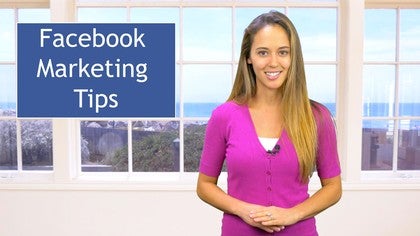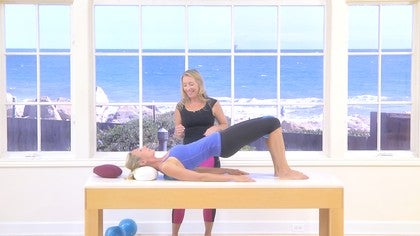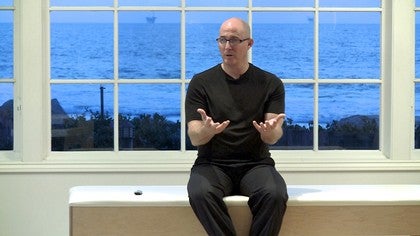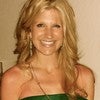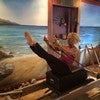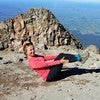Description
If you feel that we have left any topics out, believe certain topics should have been explored in greater detail, or have suggestions for future video topics, we would love to hear your feedback in the comments section below.
| Free Facebook Marketing | 39m 40s | |
| Chapter 1 | Introduction | 2m 51s |
| Chapter 2 | What is a Facebook Page? | 2m 5s |
| Chapter 3 | Before Creating a Page | 1m 52s |
| Chapter 4 | Creating a Page | 14m 46s |
| Chapter 5 | Facebook Analytic Tool | 1m 11s |
| Chapter 6 | Facebook Events | 4m 8s |
| Chapter 7 | Posting Best Practices | 4m 14s |
| Chapter 8 | Adding Post Filters | 1m 45s |
| Chapter 9 | How to Make Engaging Posts | 5m 12s |
| Chapter 10 | Promoting Your Page | 0m 52s |
| Chapter 11 | Delegating Page Management | 0m 34s |
| Chapter 12 | Conclusion | 0m 20s |
About This Video
Transcript
Read Full Transcript
Chapter 1
Introduction
Are you on Facebook? Do you have a Facebook page for yourself as an instructor or a studio owner? No. Why not? According to a March, 2014 statistic from Facebook, there is an average of 802 million users that are logged in on a daily basis, 802 million. In this beginning level tutorial, I'm going to cover basic overview on free marketing using Facebook for plotting as instructors and studio owners. We won't address paid advertising in this series only free features. We'll explore what a Facebook page is, why it's important for plots, instructors, and studio owners to create a page, discuss best practices for how and what to post on your page to keep your fans engaged. The key features, the pages, and how to promote your page.
Throughout this tutorial, we'll be going into the Facebook interface and walk you through step by step how to create your page. Keep in mind that Facebook constantly updates his look and functionality, so what you will be seeing now may look slightly different later, but the key features should be the same. There is a lot to go over, so let's get started. The first assumption with Facebook is that it's just a place to post selfies and pictures of your dog or selfies with your dog. If you're busy teaching all day every day, you may not realize the value of spending your few moments of free time managing a Facebook page, but you should not ignore the fact that most potential clients use the internet to search for studios. And did you know that Facebook is also a search engine? People can search for Pilati studio and nearby results will pop up in their search results.
Why not be the studio instructor people find when they decided to search for one on a whim? Because Facebook is one of the most trafficked websites in the world. A page will give you search engine optimization advantages, meaning you may appear on the first page of the Google search result when potential clients search for your studio online, having a pages free, the only cost is putting in the proper time and care to take advantage of this exciting, potentially viral platform. Just how potentially viral, well, let's use Facebook statistics that 802 million users log on every day. The average user has over a hundred friends. Each time a fan likes or comments on any of your pages posts, their friends can see that post whether or not your fans friends are your fans. Thus you have the potential to indirectly spread your brand to a hundreds or even thousands of people instantly.
We all know that people trust word of mouth, business referrals from someone they know over marketing from someone they don't know. The beauty of Facebook is that we've entered into a world of social media marketing, whereas word of mouth marketing is difficult to quantify, but social media marketing, you can track the spread of your business by the amount of likes, comments, and shares you get, and more importantly, it is incredibly easy to make instant connections.
Chapter 2
What is a Facebook Page?
You probably have or are at least familiar with a Facebook profile, but if Facebook page is different than a personal profile, pages are for businesses, organizations, and brands. Just like Priscilla timelines. You can customize pages by adding apps, posting stories, hosting events, and more. While you are only permitted to have one personal Facebook account, there is no limit on the number of Facebook pages you can create. However, you must have a personal Facebook account in order to create a page and we'll use your personal Facebook account login information to create that page. Here are some differences between pages and personal accounts.
On a Facebook profile you have friends, but on a Facebook page you have fans. It is essentially the same thing except you are limited to 5,000 friends on your personal account, but can have an unlimited number of fans on your page. Pages are heavily indexed by search engines, whereas profiles are not because of privacy restrictions. So if you want online exposure with search engines, pages are the way to go. When you have a page, you have access to a new set of admin tools that help you manage your posts and track user engagement.
This is what makes social media marketing a quantifiable branding resource. Some velocities, instructors who already have a Facebook profile use their personal account for professional purposes. Either they don't think they need a Facebook page since their personal account works for them, or they may be daunted by having to start something unknown from scratch. Whatever the reason it is simply unprofessional in our social media age to share personal details of your life with your clients that would normally be exclusive to friends and family of Facebook group is a closed space for small communities of people to communicate about shared interests and can be created with any type of account. They are not accessible to users outside the group. Like pages are a page is public to all Facebook users.
So if your goal is to market to as many people as possible, a Facebook page maybe better suited for you than a Facebook group.
Chapter 3
Before Creating A Page
Before creating a page, you want to first have some marketing assets already prepared. These include a headshot, a logo, and a banner. All materials that you should have anyways when you begin branding yourself or your studio. Now, creating these assets are out of the scope of this tutorial. So if you do not already have them, you can come back to this chapter later.
You should prepare a profile, photo or logo depending on how you want to represent your business. If you're a solo instructor, for example, you may just want to professional headshot, but as studio may want to logo, Facebook recommends a square ratio that is at least 180 by 180 pixels, which will appear as 160 by 160 pixels on your page. When people view this profile image, it will also be displayed as a smaller thumbnail, so it's important that the image you choose is still recognizable at different sizes. A banner is a larger image that is displayed on the top of your page. Unlike your profile image, the banner image is something that you want to change every three months or so to keep your page fresh and updated. You want to use an image that draws attention and represents your brand.
Begin to store photos of your team, yourself, and your studio to give fans a window inside the culture and atmosphere of your business. If you don't already have this for your business, think of taglines, catch phrases and biography information that you will use to fill out your page profile. Most of this information will be written in the about section of your page. The goal of collecting all this material prior to creating your page is to make sure you have content to fill out your timeline completely and stay up to date with postings. Your page timeline represents the history of your business. Not Updating your timeline is like having a wear closed sign outside your studio door 24 hours a day. No one wants that.
Chapter 4
Creating a Page
Here we see a bunch of different categories in which under which you can create your page. This is very important because depending on the type of business you have, you'll select a different category. So for example, local business or place would be great for someone who has a physical location, a mostly one studio location because you'll be asked for that particular address. And this will allow you to be able to list your hours of operation, uh, parking information, uh, gives your clients the ability to check into your business on Facebook, something we'll talk about later. And it also allows your clients to write reviews of that one studio. The most fitting sub category for us would be local business because it would be a studio location. If you were to, for example, have multiple studio locations or at the part or own a franchise, it might be more fitting for you to select the category company, organization, or institution. So in clicking on that, uh, the benefit with this category is that you can have multiple locations, um, and your clients can still check into the company regardless of which location they attend. So here are the subcategories.
We would most likely select, um, health and beauty for purposes of plots. These businesses. The third option, which is great for individual plots, these instructors are someone who wants to build a brand of fitness brand around their business would be artists, band or public figure. And is great because you don't necessarily put in a physical studio location. You're just developing a brand around yourself. People can follow you, see what you're doing, what studios you're teaching, at, what workshops you're holding. And here, um, because there's nothing that says PyLadies instructor or fitness instructor, the most fittings, sub category selected, most likely be the public figure. So for me, because I want to have a home studio, I would pick local business or place to get started with my Facebook page.
It's important to note before we create the page that you can all always change your main category designation down the road. So if you want to start as an artist band or public figure by building your own personal brand, but you don't have your own studio location yet, you would create your Facebook page using that selection. And then down the road when you open your studio and you have a physical address, you can switch that Facebook page category to local business or place. Here we're going to select local business and enter the business name and address. And for our phone number I'm going to use the is anytime main customer service lines. So if you have any questions about this tutorial, you can give us a call down the [inaudible]
You'll be directed to the about page here. With this first section, it's asking you to list specific categories that will help you improve your pages, search rankings when people try to search for your business. So here we're gonna add different terms that I think would characterize my plotty studio, which should be, um, is the yoga and pilates. For example, physical fitness, fitness center. And these terms are really important because Facebook will conduct searches using these terms. So for example, if I went in and I was sitting at home and I wanted to find my local plotty studio, I would say plotty studios nearby. And as you see the category, Yoga and pilates pops up.
So anything that lists yoga and ease is one of their category words will show up in my search results. That's why it's important to maybe include more than one category. So if someone's searching for fitness center or fitness nearby, your page will pop up. And the next section is the about box. So you'll add a few sentences to tell people what your page is about.
This will also help it show up in the right search results when people search for your page. So you're limited to 155 characters here, so it's a relatively short description and you want pack it full of key words and later on down the road you will be able to add more to your description. But for now, we're limited to this 155 characters. So, um, I've made this short description to show up on my page. I currently don't have a website, so I'm going to leave this box blank. And then the last line, it just says is mw Plata is a real establishment business or venue. Now, I know it's not established yet, but I am hoping in the near future that it will be. So for purposes of this tutorial, I'm going to click yes and then you see the last statement that pops up here.
Um, am I the authorizer official representative representative of this establishment or business. And yes I am. And this is just a legally binding statement, um, regarding the authenticity and representation of this page. So you want to make sure that you are the person that owns the business or is the official representative of the business before creating this page. So we'll click yes and then just click save info at the bottom of the page. The first time that your page opens Facebook is really helpful in giving you these pop up notifications so you can see what, what tabs or features are important about the page. So this first tab getting around, lets you know that these top three tabs are pretty much, um, they contain pretty much everything you need to manage your page and we'll get into that later here it shows that you can like your own page so that at least one person has like this page prior to it's get go.
And then here we just can see that and the most important information that we need to know about notifications. Like when people comments are on our photos or like certain things on our page or when they send us messages will be easily viewed here. And here build an audience. Also lets you know that you can invite your contacts by email. You can share the Facebook page on your Facebook to help build the number of likes or the number of fans that you have on your page.
It will probably take some time to fill out the page and update your cover photo. So one thing I would suggest doing, um, in the beginning, right after creating your page is to unpublish the page. Currently it's public and people who are your Facebook friends can search for the page and find it and we want to make sure that the page is complete and has all the necessary information before it goes live. So in order to unpublish your page, you would just simply scroll to the top of the page, click on settings, and at the very top page visibility, all you have to do is click edit and then select unpublished page and save changes. And now your the public will not be able to find your page, won't be able to see the edits you're making to your page as you're making them. Now the first thing I'd like to do is to add a cover photo. So to do that in the cover photo is this long photo at the top of the page and this is the photo that we talked about earlier. So to add a cover photo, all you have to do is click on add a cover photo and I'm going to upload a photo that's been previously stored onto my computer and this is also called a banner photo
And all I have to do is select save changes. Now if you wanted to upload a cover photo that met Facebook specifications, that would be 851 by 315 pixels. And if you did upload a cover photo of that size, you wouldn't have to adjust the image within the photo by moving it top to bottom or right to left. And now down the road if you do want to change your profile photo, all you have to do is hover over your profile picture and select update profile picture. And same thing with um, how we uploaded it. Previously you would just select upload photo or take photo or choose from photos that you already have on your Facebook page.
If you want to update your cover photo or banner photo down the road, we'd simply hover over the cover photo and just select change cover. And same thing. You can upload a photo from your computer, choose from photos that are already part of your Facebook page. Now we finished the most basic steps to creating a page and it's time to fill out some more of the about section on the page. So click on about, it's looking pretty bare right now. It just start address and our phone number in his short about description. So to add more information to your page, just go ahead and scroll to the top of the page, click on settings, and then scroll down to page info. Click on that.
And here you'll see number of categories in which you can add information about the page. So for example, you could enter the hours of operation of your studio, you could enter the type of parking available, how to reach the studio by public transit, the website of the studio if you have one. Um, and then also the price range of the classes that you offer. And to edit any of these categories, all you have to do is click the edit button next to the category and fill in your information. So, for example, um, my private sessions would be a $50 or plus. So I'll click on that and then click save changes. What's, um, I consider very important here is to add more description to your page. So if you remember earlier, we could only enter 155 characters about the page when first creating the page. So here's your chance, give your fans a little bit more of a description about what your studio is about, what the culture is like, your mission statement, and what you want to accomplish as a business.
So please take a moment to fill out as much of this information as you can now. And then when you've done that, you can join me by going back up to the top of the page and clicking on general, the General Tab. So now that we have more information on our page, I think it's time to republish the page so that the public can view your page. So to do that, you'll just scroll to page visibility and then click on edit, uncheck unpublished page, and then click save changes. Now your your page is considered to be publish, which means that the public can search for and view your page. So now that your page is published, there are a few ways to get people to like your page.
The first is to build your audience by getting people to like your page. So one way you can do that is go to the build audience tab, click on that with the dropdown tab and then click invite friends. So here you can invite your personal Facebook friends through this tab and you'll see a list of my friends pop up and then I can click invite next to each person that I want to have like my page. And the second way that you can generate likes for your page is to again go to the build audience tab, click on that and then click on import contacts. This is great for importing the contact information of people who subscribe to your newsletter, who are your colleagues, but maybe not your Facebook friends.
It's a good way to reach people outside of your Facebook network. I use Gmail, so I'm going to click on other email service. And then click invite contacts. I'll enter my Gmail address and then click invite context and you'll see that Facebook has a pop up that gives me detailed instructions on how to export my email contacts from Gmail into Facebook. So with whatever email service we use, this will pop up and it'll walk you through step by step how to get those contacts into your Facebook page account. So scrolling down you can choose which specific contacts you want to download and then you would export that information in a CSV file and upload it to Facebook using their uploader here. The third way to get people to like your Facebook page is to share the page through your own personal Facebook account. So to do that, you would go to this symbol with three dots at the bottom right corner of the cover page and you would click on that symbol and click share.
And here you'll see that you can share your Facebook page on your own timeline, on a friend's timeline, in a group, or on a page that you manage. Also in a private message. I'd like to share this page on my own personal Facebook timeline. So I'm just going to write a quick message to my friends and then I would make sure that this status update is going to go just to my friends. And you'll see the link to the new page that we just created and this exact post will appear once I click share page, it'll show up on my personal Facebook account timeline for all of my Facebook friends to see. And it'll also be, um, disseminated throughout my Facebook friends timelines as well.
And this is great because generally when you're first getting started, your friends and family will be more than happy to support you by liking your page and just building that fan base so that you can get to your page insights and spread your network. Okay.
Chapter 5
Page Analytics and Tools
Once you've created your page, you have access to tools that'll help you manage that page. So going to the top of the Facebook page, you'll see tabs, let's say page activity, insights and settings. Your insights tab won't appear until you've had at least 30 fans or 30 likes on your page. Clicking on the activity tab. This tablets show you all of the recent notifications that have happened on your page, so any time a fan likes a link of yours, like the post likes a photo or shares one of your photos or posts, you'll see that activity in your notifications. On this tab, you can also view the messages that your fans have sent you and respond to them.
You can promote your page through paid advertising and also invite your email contacts to like your page. Moving on up to the settings tab, if you check out the activity log, it'll show all of the posts that your page has made, so all of your personal page activity and the history of that activity.
Chapter 6
Facebook Events
Your Facebook page is a great way to share with your fans information about events or workshops that you're hosting in the future. So on Facebook you can create events by clicking on the event milestone button and then clicking on event. No, let's just steam our event. It's a workshop that I would like to host at my studio plots for the first time client. And I'll just say please join me at this workshop at my new studio and the location will be um, Maria Wheeler piles, which we'll link to my page and let's set it for seven o'clock. I'm not quite sure what the, whether it be looks like Facebook guests that for me and as a category I'm selecting learning. And then workshop.
I'd like anyone, any of my fans to be able to post the event wall. So I'm not going to check this box that says only admins can post to the event wall. And then you can also add targeting, um, to your workshops. So for example, if your workshop is for plots for prenatal PyLadies or postnatal pilates for Moms, you'd likely want to target by gender making sure that only women see this event. But here, this workshop is great for any, any type of person. So I'm not going to target the event and all you have to do is click create. Yeah.
And here to make the event page look a little more interesting. You'd want to add an event photo. For purposes of this tutorial, I'm just going to use my banner photo. So you click on add event photo and then choose from my photos and choosing from my photos. We'll just display whatever photos you've uploaded to your Facebook page and click on the photo and reposition the photo by dragging it from left to right and up and down if necessary. And then click save changes. And here you'll see the date of the event, even the weather for the event.
Oh, and it looks like I still need to add a time. So we're going to add that time and it should be 7:00 PM hey click save. Now that you've created your event, you'll want to invite your page fans to join you at the event. To do so, just scroll to the upper right corner of the page, click invite, and then click choose friends. And here you'll see a list of all of your personal Facebook friends and you can select however many you want searching by their name or other categories. And once you've done so you would click send. I know once you've invited friends to your guests lists, when someone joins your event, you'll see them pop up in the RSVP list along with their photo.
So now I've RSV peed myself and you'll see that there are, you couldn't, your guests can even RSCP. Maybe another free way to promote your workshop would be to share the event on your personal Facebook timeline. To do so, you'd click on invite, click on share event, and then just like sharing the page on your timeline, which we did before, you have the option to write something and you also have the option of who you want to share this message with.
Chapter 7
Posting Best Practices
Why should you care if your posts are engaging? Facebook uses an algorithm called edge rank, which determines which posts are most relevant to each individual user's newsfeed and will assign a value to each post.
So not all of your fans will see every post you create in their newsfeed. The value is dependent on how engaged your fans are with the post measured by how often they like click comment on or share the post. The higher the edge ring score of your posts, the more likely Facebook users will see your posts in their newsfeed. So do you use this to your advantage? You need to post comments that are not only relevant to your business but also timely and targeted to your appropriate audience in the social media sphere.
The line between being informative and being annoying is the balancing act. How often do you post depends on your pages fan base. Each page has a unique audience that may respond better to more or fewer updates. A way to test what your fan base wants is to start with an average of five posts a week. Then increase that amount the next few weeks. Then reduce that amount and other weeks you'll use your page insights tool to gauge what your fans are responding to.
Let's quickly take a look at the page insights option for quick measure of how engaging a post is. All you'll have to do is click on the insights link. Keep in mind that this tab will not appear until you've had at least 30 fans like your page to quickly see whether or not a post is engaging. Click on your five most recent posts and a page with all of the past posts that will pop up here. We can see just how engaging these posts are. There are a couple that stand out and questions that we want to ask, or is it because of the time of the posting? Is it the content or the type of post?
Since not all of your fans are going to see all of your posts in their newsfeed, you won't be annoying them with an excess of posts. However, don't keep posting just for the sake of trying to reach more people because Facebook doesn't work that way unless people are engaging with your posts through comments, clicks and likes. Less than less of your fans will see your posts. It's really more about quality than quantity. Once you've started posting things on your page as timeline, you'll find that your fans will start to interact with your posts by liking on them or commenting on them. It's very important to maintain a dialogue and to respond to every comment that's written on your page that shows your clients and customers that you're a responsive business owner that cares about their needs.
And so here in this upper right hand corner, you'll see any type of notification, which generally shows up when someone sends you a message or comments on one of your posts. And here you'll see that someone has liked one of our posts and is also commented on one of our posts. And just to show you how to reply to that comment,
Chapter 8
Scheduling and Filtering Posts
Everyone will still be able to see the post on your pages timeline, but it will help prevent oversaturation of posts on other people's news feeds, which will in turn help prevent fans from thinking that you're spamming them with too much information. Posts can be scheduled up to six months in advance of the date and time that you want to post to appear. Maybe you want to post to appear during high user traffic times. You can even edit the dates of previously posted items and add posts to your timeline. For a date in the past. If you do, the posts will immediately appear in the appropriate place on your pages timeline. Since you have the ability to schedule a post in advance, I would suggest picking your least busy work period during the week to schedule the next week's posts. For me, Fridays tends to be my slowest teaching days, so I would block out a few hours in the middle of the day to think about my strategy for next week's Facebook posts. Facebook suggests that highest site usage is that 11:00 AM 3:00 PM and 8:00 PM Eastern Standard Time with Wednesday at 3:00 PM the busiest time of the week.
Sundays have the least Facebook activity. Facebook also states that morning post performed 40% better than those in the afternoon, so any major story posts should be released before 11:00 AM eastern standard time, so choose a time that makes sense for your fans. This will require you to experiment with different times at first to see what works best.
Chapter 9
How to Make Engaging Posts
How do you make an engaging post? What secret sauce do you need to incorporate generally as a guideline?
Short status updates or one or two lines of text. Get 60% more likes, comments and shares. Keep it to the basics of who, what, where, when, why, and how and limit personal feelings and posts. Facebook has found that the most engaging types of posts are short, original benefit. The person viewing the content and connect to your business objectives and identity and other words. Ask Yourself, who is my audience?
What are they looking for from me and what can I post to make them happy and interested? Facebook recommends three types of posts. The first is photos or videos, something visually stimulating and bright colorful images depicting human interactions such as people enjoying their experience with your product or service. Real images are usually preferred. Overstock photos, you can do something fun like posting a picture and asking your fans to come up with creative captions for it. The second is Facebook offers discounts or coupons that users just can claim and share with their friends. However, you must have at least 50 fans that like your page before you can create an offer. The third is a post that as a yes or no question, people are more likely to engage with you. If you ask for a simple one word response. Also be sure to respond to comments. If you ask questions in general, you want to be creating conversations with your clients on your page.
You can create fill in the blank posts. For example, my favorite PyLadies exercise is blank or posts that say like this, post a few agree which will get more traffic to the posts through your fans. It's also a good idea when sharing links to put the links directly in the text of the post rather than using the Facebook tool to attach a link to a post. This will help you with your search engine optimization and Facebook has found that links with longer URLs get three times the engagement on Facebook because for whatever reason people trust it more. If you were at a loss for what to post on your page, I would suggest liking the pages of other PyLadies organizations, businesses and groups on Facebook. One such organization is the plot is method alliance.
You can also find great plots, articles on [inaudible] dot about.com the major plot is teacher training organizations also regularly posts, photos, articles and videos on their Facebook pages. You can share their content that you find the most relevant and engaging to your fans or get your own ideas for what to post because we've discussed that. Photos and video posts are some of the most engaging types of posts on Facebook pages. I'd like to show you how to create a photo
So Facebook allows you to click on the upside down triangle, click star highlight and you'll see this banner with the star up here on the upper right corner of the post. And that just what that does is that just lets your fans know that if they're scrolling through your page and they want to look just for what's important to them or what you would consider to be important for them, they can find that star symbol and know that maybe they should pay a little more attention to that post. You can also pin a post to the top of your page. So if you have a certain type of post that you want to ensure it remains at the top of your page, regardless of how many posts that you're posting, you would pin the post. So for example, I've added a mat class on Fridays to my schedule and I want to make sure that for the entire week anyone who visits my page will see that post for sure. And one way to do that is make sure that that post stays at the top of the page. So to pin the post would go to the upside down triangle symbol one more time, and then click pin to top and you'll see that that post has made it to the top of my page.
And this little symbol right here indicates that that post was pinned. And so now if I, um, enter a later post, so I'll just say something, you know, just as an example, happy Friday everyone and post. And if I refresh that page, you'll see that my pin posts remains at the top of my timeline.
Chapter 10
Promoting Your Page
You can also email your customers to invite them to your Facebook page at a like button to your website and blogs, post Facebook offers and create Facebook ads. You should create a unique page, user name or a URL to disseminate in your marketing materials, which may also improve your studio search results on Google. A Facebook username can be created by going to facebook.com/username and editing the about me section of your page. Be careful because you can only change your unique username one time after you create it.
Chapter 11
Delegating Page Management
Managing a page can seem like a lot of work. As the page creator.
You can give other individuals access to the page to help you manage posts, comments and advertising. Moderators can respond to and delete comments, send messages, create ads and view insights. Editors can do all of that as well as edit the page and create and delete posts as the page. You can also designate a dedicated ads manager that will have limited access to the page to create stop and edit ads from the page.
Chapter 12
Conclusion
I hope you enjoyed watching this video and that it was helpful to you.
Feel free to leave comments if you think we've missed something or to let us know what video topics or discussions you would like to see on Facebook. For pilates instructors and studio owners. Thanks for watching.
Workshops - Playlist 6: Free Workshops
Comments
You need to be a subscriber to post a comment.
Please Log In or Create an Account to start your free trial.
